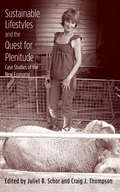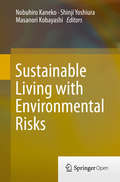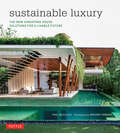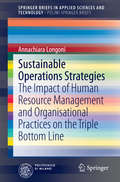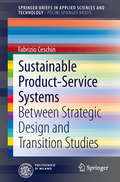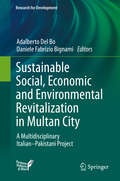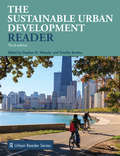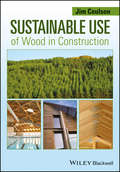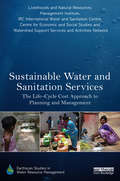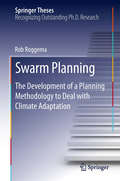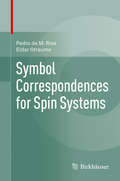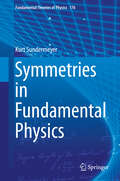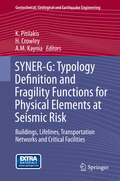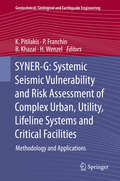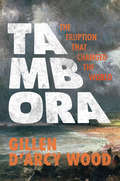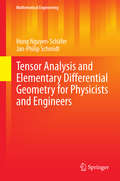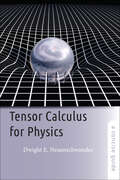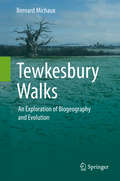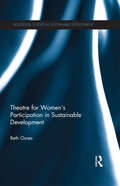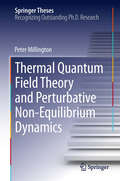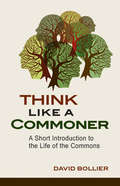- Table View
- List View
Sustainable Lifestyles and the Quest for Plenitude
by Ms Juliet B. Schor Mr Craig J. ThompsonMany of today's most troubling environmental and economic issues have come to seem insoluble: carbon emissions, overshoot, inequality, joblessness, and a dysfunctional food system. Can we change direction, move away from business as usual, and achieve a more sustainable, empowering, and humane economy? Through a fascinating array of illuminating case studies, this hope-filled book affirms that we can. In locations across the United States and around the globe, local participants are forging their own versions of small-scale, low-footprint, high-satisfaction lifestyles and communities. From raw-milk consumers and members of alternative agricultural initiatives to time bankers, artisan producers in the Aude region of France, and bicycle mechanics on the South Side of Chicago, individuals and small groups are exploring the practice of plenitude. Their efforts demonstrate how social and economic transformation happens and suggest new paths toward larger-scale change and a richer quality of life for all.
Sustainable Living with Environmental Risks
by Nobuhiro Kaneko, Shinji Yoshiura and Masanori KobayashiWe are not free from environmental risks that accompany the development of human societies. Modern economic development has accelerated environmental pollution, caused loss of natural habitats, and modified landscapes. These environmental changes have impacted natural systems: water and heat circulation, nutrient cycling, and biodiversity. These changes in natural systems degrade ecosystem services and subsequently increase environmental risks for humans. Environmental risks, therefore, are not only human health risks by pollution, climatic anomalies and natural disasters, but also degradation of ecosystem services on which most people are relying for their lives. We cannot entirely eliminate the risks, because it is not possible to attain zero impact on the environment, but we need to find a mechanism that minimizes environmental risks for human sustainably. This is the idea of the interdisciplinary framework of “environmental risk management” theory, which advocates harmony between economic development and environmental conservation. Based on this theory, the Sustainable Living with Environmental Risk (SLER) programme, adopted by the Japanese Ministry of Education (MEXT) as one of its strategic programmes, has been training graduate students at the Yokohama National University, Japan, from 2009 to 2013 to become future environmental leaders who will take the initiative in reducing the level of environmental risks and in protecting natural resources in the developing nations of Asia and Africa. This book provides students and teachers of this new academic field with a comprehensive coverage of case studies of environmental risks and their practical management technologies not only in Japan but also in developing nations in Asia and Africa.
Sustainable Luxury
by Paul Mcgillick Masano KawanaSingapore is celebrated as one of the most livable cities in Asia, and Sustainable Luxury shows how the prosperous, forward-looking nation is pioneering innovative solutions for environmental, economic, social, and cultural issues faced the world over. Dr. Paul McGillick, the author of The Sustainable Asian House (Tuttle, 2013), presents twenty-seven recent residential projects created by Singapore's most talented architects to address the many complex and interconnected aspects of sustainability.Some of the homes featured here emphasize environmental needs, while others are concerned with preserving cultural traditions or supporting societal and interpersonal needs-such as extended family dwellings. Each residence, however, exhibits solutions developed from a holistic point of view. These homes typically embrace the tropical climate rather than fight it, and illustrate how smart manipulation of air flows, light, shade, water, and landscaping sustain higher levels of comfort without resorting to air-conditioning.In addition to profiling individual residences, Sustainable Luxury looks at the big picture, canvassing the most pressing issues-including changing demographics and lifestyles-and examining the available solutions. Anyone concerned with the future of our world will be fascinated by the houses presented here and the ways in which Singapore is leading the way in the development of residential architecture that is as luxurious as it is sustainable.
Sustainable Luxury
by Paul McgillickSingapore is celebrated as one of the most livable cities in Asia, and Sustainable Luxury shows how the prosperous, forward-looking nation is pioneering innovative solutions for environmental, economic, social, and cultural issues faced the world over. Dr. Paul McGillick, the author of The Sustainable Asian House (Tuttle, 2013), presents twenty-seven recent residential projects created by Singapore's most talented architects to address the many complex and interconnected aspects of sustainability. Some of the homes featured here emphasize environmental needs, while others are concerned with preserving cultural traditions or supporting societal and interpersonal needs-such as extended family dwellings. Each residence, however, exhibits solutions developed from a holistic point of view. These homes typically embrace the tropical climate rather than fight it, and illustrate how smart manipulation of air flows, light, shade, water, and landscaping sustain higher levels of comfort without resorting to air-conditioning. In addition to profiling individual residences, Sustainable Luxury looks at the big picture, canvassing the most pressing issues-including changing demographics and lifestyles-and examining the available solutions. Anyone concerned with the future of our world will be fascinated by the houses presented here and the ways in which Singapore is leading the way in the development of residential architecture that is as luxurious as it is sustainable.
Sustainable Operations Strategies
by Annachiara LongoniThis book provides detailed guidance on how sustainability, in terms of the triple bottom line, can be developed in operations strategies via human resource management (HRM) and organizational practices such as teamwork, training and employee involvement. The impacts of HRM and organizational practices on environmental and social sustainability, trade-off optimization and the triple bottom line are carefully analyzed, with attention to aspects including organizational responsibility and worker commitment to sustainability. Valuable tips are offered on formulation and implementation of sustainable operations strategies and in addition the alignment of lean manufacturing and the triple bottom line is addressed in a dedicated section. The background to the book and the reason for its topicality, is the difficulty that companies are experiencing in defining and implementing effective sustainability programs that enhance environmental, social and economic sustainability and optimize possible trade-offs. Moreover, although the operations management literature has focused mainly on technical aspects, HRM and organizational practices may also be relevant in enhancing programs' effectiveness and directly impacting sustainability.
Sustainable Product-Service Systems
by Fabrizio CeschinThis book investigates the potential contribution that a strategic design approach can make to stimulating and supporting the societal embedding of sustainable PSSs (product-service systems). A new strategic design role thus emerges; a role in which the ideation and development of sustainable PSS concepts is coupled with the designing of appropriate transition paths (sequence of socio-technical experiments) to gradually incubate, introduce and diffuse these concepts. The book also outlines the new design approach and capabilities needed by strategic designers, project managers and consultants to operate at such a strategic level. On a more operational point of view, the work presents a practical "how to do" design process and associated guidelines to support practitioners in designing and managing the societal embedding process of sustainable PSS innovations.
Sustainable Social, Economic and Environmental Revitalization in Multan City
by Adalberto Del Bo Daniele Fabrizio BignamiThis book describes six months of initial intensive activities within a motivating multidisciplinary project to achieve sustainable social, economic, and environmental revitalization in the historic core of Multan City, Pakistan. The project is managed by Fondazione Politecnico di Milano within the framework of the "Pakistan-Italian Debt for Development Swap Agreement" and has five components: a livelihood improvement program, a living conditions improvement program, revitalization of physical assets, establishment of a Pakistan-Italian resource centre in Multan, and an Italian collaboration program for training and capacity building. All aspects are covered in this book, which provides a comprehensive account of progress in this excellent example of cross-cultural cooperation between a Western and an Eastern country in regenerating an historic populated site.
Sustainable Urban Development Reader (Routledge Urban Reader Series)
by Timothy Beatley Stephen M. WheelerBuilding on the success of its second edition, the third edition of the Sustainable Urban Development Reader provides a generous selection of classic and contemporary readings giving a broad introduction to this topic. It begins by tracing the roots of the sustainable development concept in the nineteenth and twentieth centuries, before presenting readings on a number of dimensions of the sustainability concept. Topics covered include land use and urban design, transportation, ecological planning and restoration, energy and materials use, economic development, social and environmental justice, and green architecture and building. All sections have a concise editorial introduction that places the selection in context and suggests further reading. Additional sections cover tools for sustainable development, international sustainable development, visions of sustainable community and case studies from around the world. The book also includes educational exercises for individuals, university classes, or community groups, and an extensive list of recommended readings.The anthology remains unique in presenting a broad array of classic and contemporary readings in this field, each with a concise introduction placing it within the context of this evolving discourse. The Sustainable Urban Development Reader presents an authoritative overview of the field using original sources in a highly readable format for university classes in urban studies, environmental studies, the social sciences, and related fields. It also makes a wide range of sustainable urban planning-related material available to the public in a clear and accessible way, forming an indispensable resource for anyone interested in the future of urban environments.
Sustainable Use of Wood in Construction
by Jim CoulsonThere is a great deal of innovation in the use of wood in construction, from impressive modern buildings to new construction products that reduce build times and improve building performance. As a renewable resource with proven low embodied energy, wood is both an environmentally responsible and a highly practical choice as a construction material. However, forest management practices vary throughout the world: some are highly effective in delivering a sustainable, long term supply of timber; whereas others are less so, and could result in forest depletion and significant environmental degradation. Against this background, a number of certification schemes have been developed that seek to ensure that all timber is harvested from sources that are at least legally-sourced, and at best, sustainably managed. Sustainable Use of Wood in Construction explains how and why wood may be grown sustainably, and how this versatile material can be specified and - most importantly - sourced, for use in the construction industry. It explains the modern regulatory framework within Europe that seeks to eliminate the use of illegally-harvested wood, and it shows how to ensure that everyone who sells or uses wood for construction is following the rules. Finally, the book explains how, at the end of its first use in construction, wood can be recycled, by reprocessing into another wood-based construction material, or by using it as biomass. Also available Wood in Construction: How to avoid costly mistakes Jim Coulson Paperback, 978 0 4706 5777 Structural Timber Design to Eurocode 5 Second Edition Jack Porteous & Abdy Kermani Paperback, 978 0 4706 7500 7
Sustainable Water and Sanitation Services: The Life-Cycle Cost Approach to Planning and Management (Earthscan Studies in Water Resource Management)
by Livelihoods & Natural Resource Managment Institute International Water & Sanitation Centre Centre for Economic and Social Studies Watershed Support Services & Activities NetworkBased on the work of the WASHCost project run by the IRC International Water and Sanitation Centre (IRC), this book provides an evaluation of the water, sanitation and hygiene (WASH) sectors in the context of developing countries and is the first systematic study of applying the life-cycle cost approach to assessing allocations. It presents unit cost estimates of the WASH sector across geographic locations and technologies, including rural and peri-urban areas, and these are compared with service levels. It analyses detailed data from more than 5000 households across nine agro-climatic zones in Andhra Pradesh State in India. Key issues assessed include poverty analysis of service levels, cost drivers and factors at the village and household level, and governance aspects such as transparency, accountability and value for money in relation to unit costs and service levels. This is the most comprehensive study of the WASH sector in India and elsewhere that utilises the life-cycle cost approach, along with GIS, econometric modelling and qualitative research methods. Not only does it contribute to research and methodology in this area, but the analysis also provides valuable insights for planners, policy makers and bi-lateral donors. The authors show how the methodology can also be applied in other developing country contexts.
Swarm Planning
by Rob RoggemaThis book shows that the problem of climate adaptation, which is described in social planning terms as 'wicked,' is at odds with the contemporary practice of spatial planning. The author proposes a new adjusted framework which is more adaptable to unpredictable, wicked, dynamic and non-linear processes. The inspiration for this new method is the behaviour of swarms: bees, ants, birds and fish are capable of self-organization, which enables the system to become less vulnerable to sudden environmental changes. The framework proposed in Swarm Planning consists of these four elements: Two levels of complexity, the first being the whole system and the second its individual components. Each of these has different attributes for adapting to change. Five layers, consisting of networks, focal points, unplanned space, natural resources and emerging occupation patterns. Each layer has its own spatial dynamic, and each is connected to a spatial scale. Non-linear processes, which emerge in different parts of the framework and include emerging patterns, connectedness and tipping points among others. Two planning processes; the first, 'from small to large' works upward from the slowest changing elements to more rapidly-changing ones. The second, 'on the list of partners' addresses each layer from networks through emerging occupation patterns. Swarm Planning applies this framework to a series of pilot studies, and appraises its performance using criteria for an adaptive landscape. The results show that the use of the Swarm Planning Framework reduces the vulnerability of landscapes as well as the impact of climate hazards and disasters, improves response to unexpected hazards and contains adaptation strategies. "This book is a must for planners in government and the private sector as it outlines the concept, strategies and techniques for swarm planning. It is also an important guide for policymakers looking to engage communities in a dialogue about the adaptation planning process. " Professor John Martin, La Trobe University "The ultimate value of the book lies in encouraging the planning community to consider options that go far beyond those offered by business-as-usual planning methodologies developed for a set of operating conditions that are fast becoming obsolete. As such it makes an important and much needed contribution to the field. " Assistant Professor Dr. Chrisna du Plessis, University of Pretoria
Symbol Correspondences for Spin Systems
by Pedro de M. Rios Eldar StraumeIn mathematical physics, the correspondence between quantum and classical mechanics is a central topic, which this book explores in more detail in the particular context of spin systems, that is, SU(2)-symmetric mechanical systems. A detailed presentation of quantum spin-j systems, with emphasis on the SO(3)-invariant decomposition of their operator algebras, is first followed by an introduction to the Poisson algebra of the classical spin system and then by a similarly detailed examination of its SO(3)-invariant decomposition. The book next proceeds with a detailed and systematic study of general quantum-classical symbol correspondences for spin-j systems and their induced twisted products of functions on the 2-sphere. This original systematic presentation culminates with the study of twisted products in the asymptotic limit of high spin numbers. In the context of spin systems it shows how classical mechanics may or may not emerge as an asymptotic limit of quantum mechanics. The book will be a valuable guide for researchers in this field and its self-contained approach also makes it a helpful resource for graduate students in mathematics and physics.
Symmetries in Fundamental Physics (Fundamental Theories of Physics #176)
by Kurt SundermeyerOver the course of the last century it has become clear that both elementary particle physics and relativity theories are based on the notion of symmetries. These symmetries become manifest in that the "laws of nature" are invariant under spacetime transformations and/or gauge transformations. The consequences of these symmetries were analyzed as early as in 1918 by Emmy Noether on the level of action functionals. Her work did not receive due recognition for nearly half a century, but can today be understood as a recurring theme in classical mechanics, electrodynamics and special relativity, Yang-Mills type quantum field theories, and in general relativity. As a matter of fact, as shown in this monograph, many aspects of physics can be derived solely from symmetry considerations. This substantiates the statement of E.P.Wigner "... if we knew all the laws of nature, or the ultimate Law of nature, the invariance properties of these laws would not furnish us new information." Thanks to Wigner we now also understand the implications of quantum physics and symmetry considerations: Poincare invariance dictates both the characteristic properties of particles (mass, spin, ...) and the wave equations of spin 0, 1/2, 1, ... objects. Further, the work of C.N.Yang and R.Mills reveals the consequences of internal symmetries as exemplified in the symmetry group of elementary particle physics. Given this pivotal role of symmetries it is thus not surprising that current research in fundamental physics is to a great degree motivated and inspired by considerations of symmetry.The treatment of symmetries in this monograph ranges from classical physics to now well-established theories of fundamental interactions, to the latest research on unified theories and quantum gravity.
SYNER-G: Typology Definition and Fragility Functions for Physical Elements at Seismic Risk
by K. Pitilakis H. Crowley A. M. KayniaFragility functions constitute an emerging tool for the probabilistic seismic risk assessment of buildings, infrastructures and lifeline systems. The work presented in this book is a partial product of a European Union funded research project SYNER-G (FP7 Theme 6: Environment) where existing knowledge has been reviewed in order to extract the most appropriate fragility functions for the vulnerability analysis and loss estimation of the majority of structures and civil works exposed to earthquake hazard. Results of other relevant European projects and international initiatives are also incorporated in the book. In several cases new fragility and vulnerability functions have been developed in order to better represent the specific characteristics of European elements at risk. Several European and non-European institutes and Universities collaborated efficiently to capitalize upon existing knowledge. State-of-the-art methods are described, existing fragility curves are reviewed and, where necessary, new ones are proposed for buildings, lifelines, transportation infrastructures as well as for utilities and critical facilities. Taxonomy and typology definitions are synthesized and the treatment of related uncertainties is discussed. A fragility function manager tool and fragility functions in electronic form are provided on extras. springer. com. Audience The book aims to be a standard reference on the fragility functions to be used for the seismic vulnerability and probabilistic risk assessment of the most important elements at risk. It is of particular interest to earthquake engineers, scientists and researchers working in the field of earthquake risk assessment, as well as the insurance industry, civil protection and emergency management agencies.
SYNER-G: Systemic Seismic Vulnerability and Risk Assessment of Complex Urban, Utility, Lifeline Systems and Critical Facilities
by K. Pitilakis P. Franchin B. Khazai H. WenzelSYNER-G, a multidisciplinary effort funded by the European Union, allowed the development of an innovative methodological framework for the assessment of physical as well as socio-economic seismic vulnerability and risk at urban and regional level. The results of SYNER-G are presented in two books both published by Springer, the present and a second one, entitled "SYNER-G: Typology Definition and Fragility Functions for Physical Elements at Seismic Risk: Buildings, Lifelines, Transportation Networks and Critical Facilities"(*), which provides a comprehensive state-of-the-art of the fragility curves, an alternative way to express physical vulnerability of elements at risk. In this second volume of SYNER-G, the focus has been on presenting a unified holistic methodology for assessing vulnerability at systems level considering interactions between elements at risk (physical and non-physical) and between different systems. The proposed methodology and tool encompasses in an integrated fashion all aspects in the chain, from hazard to the vulnerability assessment of components and systems and to the socio-economic impacts of an earthquake, accounting for most relevant uncertainties within an efficient quantitative simulation scheme. It systematically integrates the most advanced fragility functions to assess the vulnerability of physical assets for buildings, utility systems, transportation networks and complex infrastructures such as harbours and hospitals. The increasing impact due to interactions between different components and systems is treated in a comprehensive way, providing specifications for each network and infrastructure. The proposed socio-economic model integrates social vulnerability into the physical systems modelling approaches providing to decision makers with a dynamic platform to capture post disaster emergency issues like shelter demand and health impact decisions Application examples at city and regional scale have provided the necessary validation of the methodology and are also included in the book. The present volume, with its companion volume on fragility functions, represent a significant step forward in the seismic vulnerability and risk assessment of complex interacting urban and regional systems and infrastructures. These volumes are not only of interest to scientists and engineers but also to the insurance industry, decision makers and practitioners in the sector of civil protection and seismic risk management. (*) Pitilakis K, Crowley E, Kaynia A (eds) (2014) SYNER-G: Typology definition and fragility functions for physical elements at seismic risk, Series: Geotechnical, Geological and Earthquake Engineering 27, ISBN 978-94-007-7872-6, Springer Science+Business Media, Dordrecht.
Tambora: The Eruption That Changed the World
by Gillen D’Arcy WoodA global history of the climate catastrophe caused by the Tambora eruptionWhen Indonesia's Mount Tambora erupted in 1815, it unleashed the most destructive wave of extreme weather the world has witnessed in thousands of years. The volcano’s massive sulfate dust cloud enveloped the Earth, cooling temperatures and disrupting major weather systems for more than three years. Communities worldwide endured famine, disease, and civil unrest on a catastrophic scale.Here, Gillen D’Arcy Wood traces Tambora’s global and historical reach: how the volcano’s three-year climate change regime initiated the first worldwide cholera pandemic, expanded opium markets in China, and plunged the United States into its first economic depression. Bringing the history of this planetary emergency to life, Tambora sheds light on the fragile interdependence of climate and human societies to offer a cautionary tale about the potential tragic impacts of drastic climate change in our own century.
Tensor Analysis and Elementary Differential Geometry for Physicists and Engineers (Mathematical Engineering)
by Hung Nguyen-Schäfer Jan-Philip SchmidtTensors and methods of differential geometry are very useful mathematical tools in many fields of modern physics and computational engineering including relativity physics, electrodynamics, computational fluid dynamics (CFD), continuum mechanics, aero and vibroacoustics and cybernetics.This book comprehensively presents topics, such as bra-ket notation, tensor analysis and elementary differential geometry of a moving surface. Moreover, authors intentionally abstain from giving mathematically rigorous definitions and derivations that are however dealt with as precisely as possible. The reader is provided with hands-on calculations and worked-out examples at which he will learn how to handle the bra-ket notation, tensors and differential geometry and to use them in the physical and engineering world. The target audience primarily comprises graduate students in physics and engineering, research scientists and practicing engineers.
Tensor Calculus for Physics: A Concise Guide
by Dwight E. NeuenschwanderUsing a clear, step-by-step approach, this book explains one of the more difficult—yet crucial—topics in physics.Understanding tensors is essential for any physics student dealing with phenomena where causes and effects have different directions. A horizontal electric field producing vertical polarization in dielectrics; an unbalanced car wheel wobbling in the vertical plane while spinning about a horizontal axis; an electrostatic field on Earth observed to be a magnetic field by orbiting astronauts—these are some situations where physicists employ tensors. But the true beauty of tensors lies in this fact: When coordinates are transformed from one system to another, tensors change according to the same rules as the coordinates. Tensors, therefore, allow for the convenience of coordinates while also transcending them. This makes tensors the gold standard for expressing physical relationships in physics and geometry. Undergraduate physics majors are typically introduced to tensors in special-case applications. For example, in a classical mechanics course, they meet the "inertia tensor," and in electricity and magnetism, they encounter the "polarization tensor." However, this piecemeal approach can set students up for misconceptions when they have to learn about tensors in more advanced physics and mathematics studies (e.g., while enrolled in a graduate-level general relativity course or when studying non-Euclidean geometries in a higher mathematics class). Dwight E. Neuenschwander's Tensor Calculus for Physics is a bottom-up approach that emphasizes motivations before providing definitions. Using a clear, step-by-step approach, the book strives to embed the logic of tensors in contexts that demonstrate why that logic is worth pursuing. It is an ideal companion for courses such as mathematical methods of physics, classical mechanics, electricity and magnetism, and relativity.
Terrestrial Biosphere-Atmosphere Fluxes
by Russell Monson Dennis BaldocchiFluxes of trace gases, water and energy - the 'breathing of the biosphere' - are controlled by a large number of interacting physical, chemical, biological and ecological processes. In this interdisciplinary book, the authors provide the tools to understand and quantitatively analyse fluxes of energy, organic compounds such as terpenes, and trace gases including carbon dioxide, water vapour and methane. It first introduces the fundamental principles affecting the supply and demand for trace gas exchange at the leaf and soil scales: thermodynamics, diffusion, turbulence and physiology. It then builds on these principles to model the exchange of water, carbon dioxide, terpenes and stable isotopes at the ecosystem scale. Detailed mathematical derivations of commonly used relations in biosphere-atmosphere interactions are provided for reference in appendices. An accessible introduction for graduate students and a key resource for researchers in related fields, such as atmospheric science, hydrology, meteorology, climate science, biogeochemistry and ecosystem ecology.
Tewkesbury Walks
by Bernard MichauxThe book is composed of eight chapters, each of which are organised as walks around the Tewkesbury (UK) countryside, which move from the specific to increasingly broader ideas. So, the MS starts with an individual's relationship to their environment (Avon and Severn Valleys Loop) that leads to a description of conservation issues at local, national and international levels, and ultimately to a discussion of the importance of Citizen Science (Coombe Hill - Apperley -Deerhurst). The following chapter (Mythe Bridge - Forthampton - Tewkesbury) looks at science as it is actually practiced and its role in modern society by an analysis of the theory of Continental Drift and a biography of Alfred Wegener. This is a story that really deserves a much wider audience, as the idea was, in my opinion, as revolutionary as general relativity or quantum mechanics, and Wegener himself was such a heroic character. The following chapter (Tewkesbury Ham) also uses biography - this time of Alfred Russel Wallace - to investigate his ideas about how animal and plant distributions are inextricably linked to geological change. Wallace was every bit as heroic as Wegener, lived an even more adventurous life, and also deserves to be more widely known and appreciated. 2013 is the centenary of his death and he will be much in the news this year, so it would be timely to publish an account of his life and work suitable for the general public. The chapters on Wegener and Wallace set the scene for a detailed discussion of biogeography. This has been an active area of research for the past 30 years and I think it's about time that somebody wrote about what has been an intellectually exciting and profoundly significant development in our view of ourselves and the world we live in.
Texas Science (Grade #7)
by Cpo Science-Science and Living Systems <p><p> -Matter, Energy, and Cells <p> -Matter, Energy, and Ecosystems <p> -Organisms and Change <p> -Human Body Structure and Function
Theatre for Women's Participation in Sustainable Development (Routledge Studies in Sustainable Development)
by Beth OsnesThough development researchers have proven that the participation of women is necessary for effective sustainable development, development practitioners still largely lack culturally appropriate, gender-sensitive tools for including women, especially women living in poverty. Current tools used in the development approach often favour the skill set of the development practitioner and are a mismatch with the traditional, gendered knowledge and skills many women who are living in poverty do have. This study explores three case studies from India, Ethiopia, and the Guatemala that have successfully used applied theatre for women’s participation in sustainable development. This interdisciplinary book has the opportunity to be the first to bring together the theory, scholarship and practice of theatre for women’s participation in sustainable development in an international context. This work will be of great interest to scholars and practitioners in a wide variety of fields who are looking for creative solutions for utilizing the contributions of women for solving our global goals to live in a sustainable way on this one planet in a just and equitable manner.
Thermal Quantum Field Theory and Perturbative Non-Equilibrium Dynamics
by Peter MillingtonThe author develops a new perturbative formalism of non-equilibrium thermal quantum field theory for non-homogeneous backgrounds. As a result of this formulation, the author is able to show how so-called pinch singularities can be removed, without resorting to ad hoc prescriptions, or effective resummations of absorptive effects. Thus, the author arrives at a diagrammatic approach to non-equilibrium field theory, built from modified Feynman rules that are manifestly time-dependent from tree level. This new formulation provides an alternative framework in which to derive master time evolution equations for physically meaningful particle number densities, which are valid to all orders in perturbation theory and to all orders in gradient expansion. Once truncated in a loop-wise sense, these evolution equations capture non-equilibrium dynamics on all time-scales, systematically describing energy-violating processes and the non-Markovian evolution of memory effects
Thermodynamics, Kinetics, and Microphysics of Clouds
by Vitaly I. Khvorostyanov Judith A. CurryThermodynamics, Kinetics and Microphysics of Clouds presents a unified theoretical foundation that provides the basis for incorporating cloud microphysical processes in cloud and climate models. In particular, the book provides: • A theoretical basis for understanding the processes of cloud particle formation, evolution and precipitation, with emphasis on spectral cloud microphysics based on numerical and analytical solutions of the kinetic equations for the drop and crystal size spectra along with the supersaturation equation • The latest detailed theories and parameterizations of drop and crystal nucleation suitable for cloud and climate models derived from the general principles of thermodynamics and kinetics • A platform for advanced parameterization of clouds in weather prediction and climate models • The scientific foundation for weather and climate modification by cloud seeding. This book will be invaluable for researchers and advanced students engaged in cloud and aerosol physics, and air pollution and climate research.
Think Like a Commoner
by David BollierThe biggest "tragedy of the commons" is the misconception that commons are failures--relics from another era rendered unnecessary by the market and state. Think Like a Commoner dispels such prejudices by explaining the rich history and promising future of the commons--an ageless paradigm of cooperation and fairness that is re-making our world.With graceful prose and dozens of fascinating stories, David Bollier describes the quiet revolution that is pioneering practical forms of self-governance and production controlled by people themselves. Think Like a Commoner explains how the commons: Is an exploding field of DIY innovation ranging from Wikipedia and seed-sharing to community forests, collaborative consumption, and beyond Challenges the standard narrative of market economics by explaining how cooperation generates significant value and human fulfillment Provides a framework of law and social action that can help us move beyond the pathologies of neoliberal capitalismWe have a choice: ignore the commons and suffer the ongoing private plunder of our common wealth, or Think Like a Commoner and learn how to rebuild our society and reclaim our shared inheritance. This accessible, comprehensive introduction to the commons will surprise and enlighten you, and provoke you to action.David Bollier is an author, activist, blogger, and independent scholar. He is the author of six books on different aspects of the commons, including Green Governance, The Wealth of the Commons, and Viral Spiral, and is a frequent speaker at conferences, colleges and universities, and policy workshops.
